A Comprehensive Report on Business Resources at Tesco Plc: Analysis
VerifiedAdded on 2020/06/06
|13
|3192
|78
Report
AI Summary
This report provides a comprehensive analysis of the business resources utilized by Tesco Plc, a global supermarket chain. The report is structured into three key projects. Project 1 examines recruitment and retention, detailing the use of job descriptions and person specifications, as well as the importance of employability, personal, and communication skills for various job roles. Project 2 focuses on the impact of non-financial resources, specifically physical and technological resources, highlighting their significance in Tesco's operations. Project 3 explores the role of financial resources, including internal and external sources of finance, and the interpretation of financial statements like the trading and profit and loss account and balance sheet. The report also illustrates the use of budgets for financial control and cost management, including a break-even analysis. The conclusion summarizes the key findings, emphasizing the importance of effective resource management for Tesco's overall performance and long-term success.
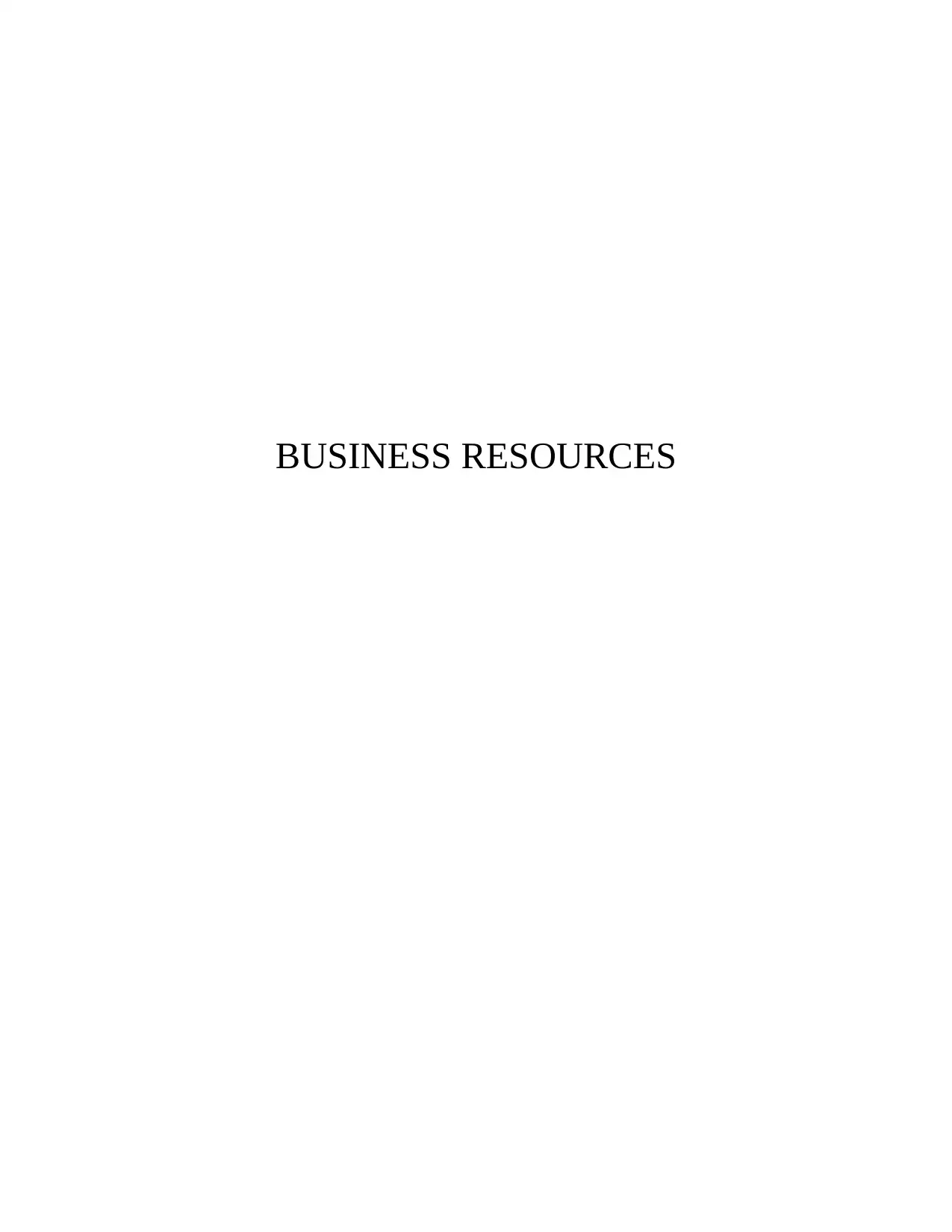
BUSINESS RESOURCES
Paraphrase This Document
Need a fresh take? Get an instant paraphrase of this document with our AI Paraphraser
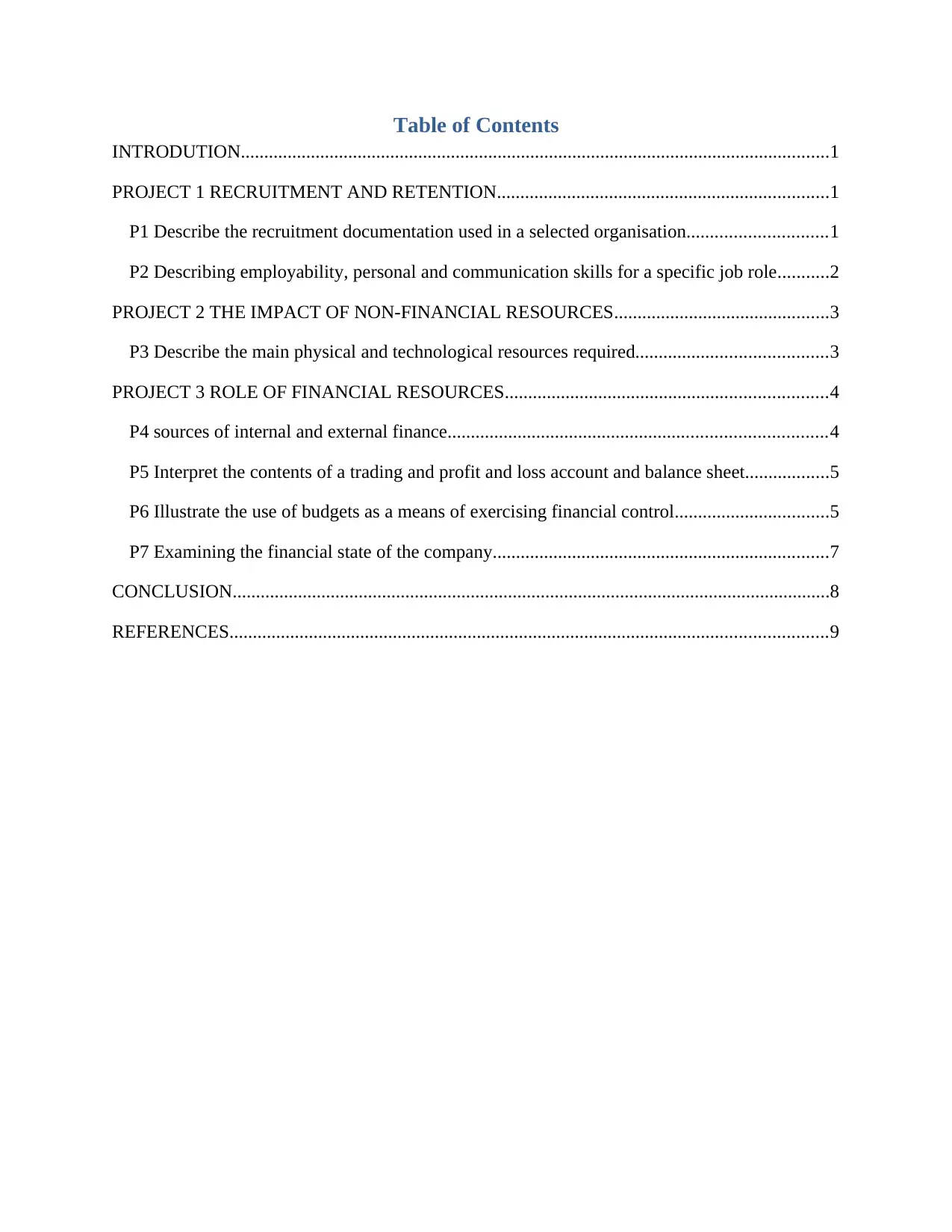
Table of Contents
INTRODUTION..............................................................................................................................1
PROJECT 1 RECRUITMENT AND RETENTION.......................................................................1
P1 Describe the recruitment documentation used in a selected organisation..............................1
P2 Describing employability, personal and communication skills for a specific job role...........2
PROJECT 2 THE IMPACT OF NON-FINANCIAL RESOURCES..............................................3
P3 Describe the main physical and technological resources required.........................................3
PROJECT 3 ROLE OF FINANCIAL RESOURCES.....................................................................4
P4 sources of internal and external finance.................................................................................4
P5 Interpret the contents of a trading and profit and loss account and balance sheet..................5
P6 Illustrate the use of budgets as a means of exercising financial control.................................5
P7 Examining the financial state of the company........................................................................7
CONCLUSION................................................................................................................................8
REFERENCES................................................................................................................................9
INTRODUTION..............................................................................................................................1
PROJECT 1 RECRUITMENT AND RETENTION.......................................................................1
P1 Describe the recruitment documentation used in a selected organisation..............................1
P2 Describing employability, personal and communication skills for a specific job role...........2
PROJECT 2 THE IMPACT OF NON-FINANCIAL RESOURCES..............................................3
P3 Describe the main physical and technological resources required.........................................3
PROJECT 3 ROLE OF FINANCIAL RESOURCES.....................................................................4
P4 sources of internal and external finance.................................................................................4
P5 Interpret the contents of a trading and profit and loss account and balance sheet..................5
P6 Illustrate the use of budgets as a means of exercising financial control.................................5
P7 Examining the financial state of the company........................................................................7
CONCLUSION................................................................................................................................8
REFERENCES................................................................................................................................9
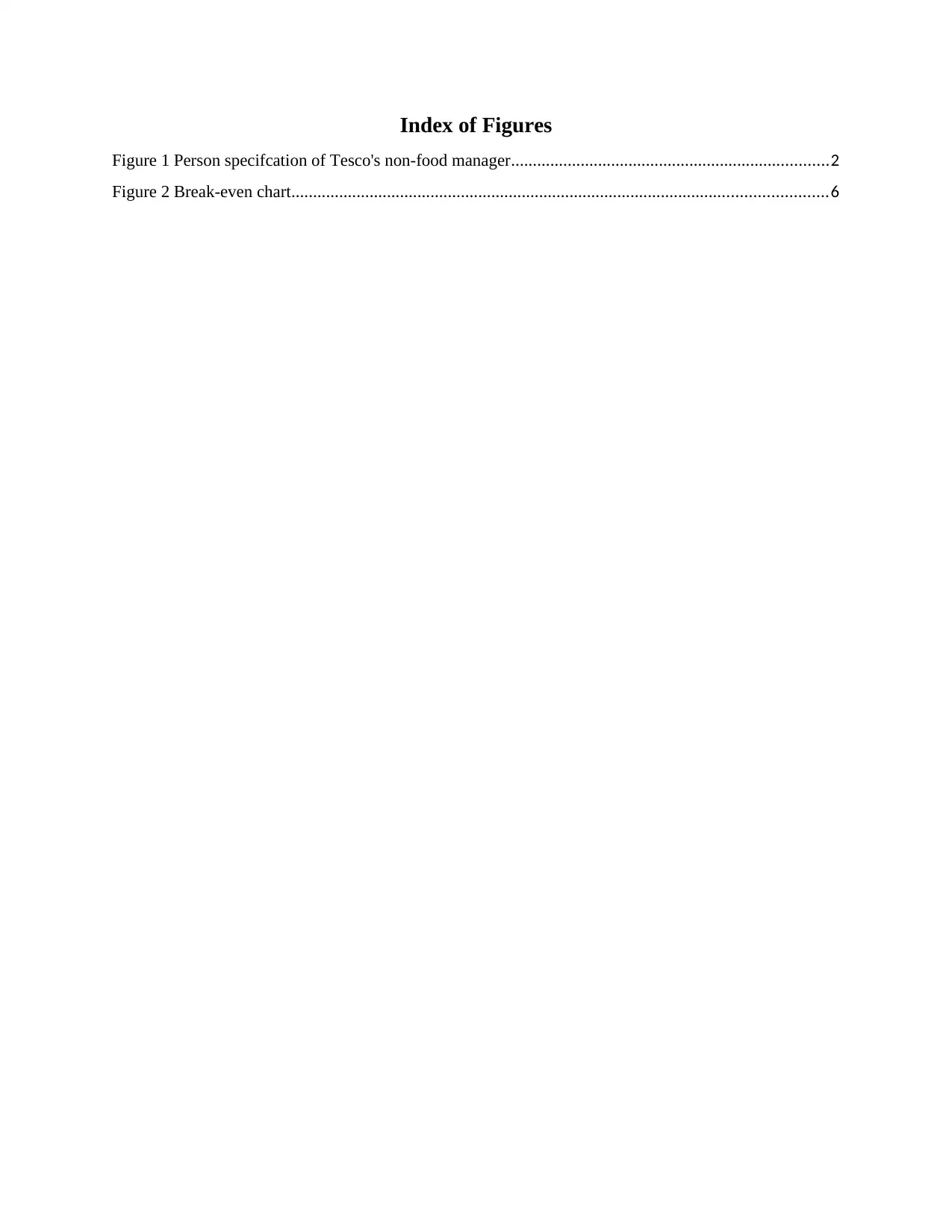
Index of Figures
Figure 1 Person specifcation of Tesco's non-food manager.........................................................................2
Figure 2 Break-even chart...........................................................................................................................6
Figure 1 Person specifcation of Tesco's non-food manager.........................................................................2
Figure 2 Break-even chart...........................................................................................................................6
⊘ This is a preview!⊘
Do you want full access?
Subscribe today to unlock all pages.

Trusted by 1+ million students worldwide
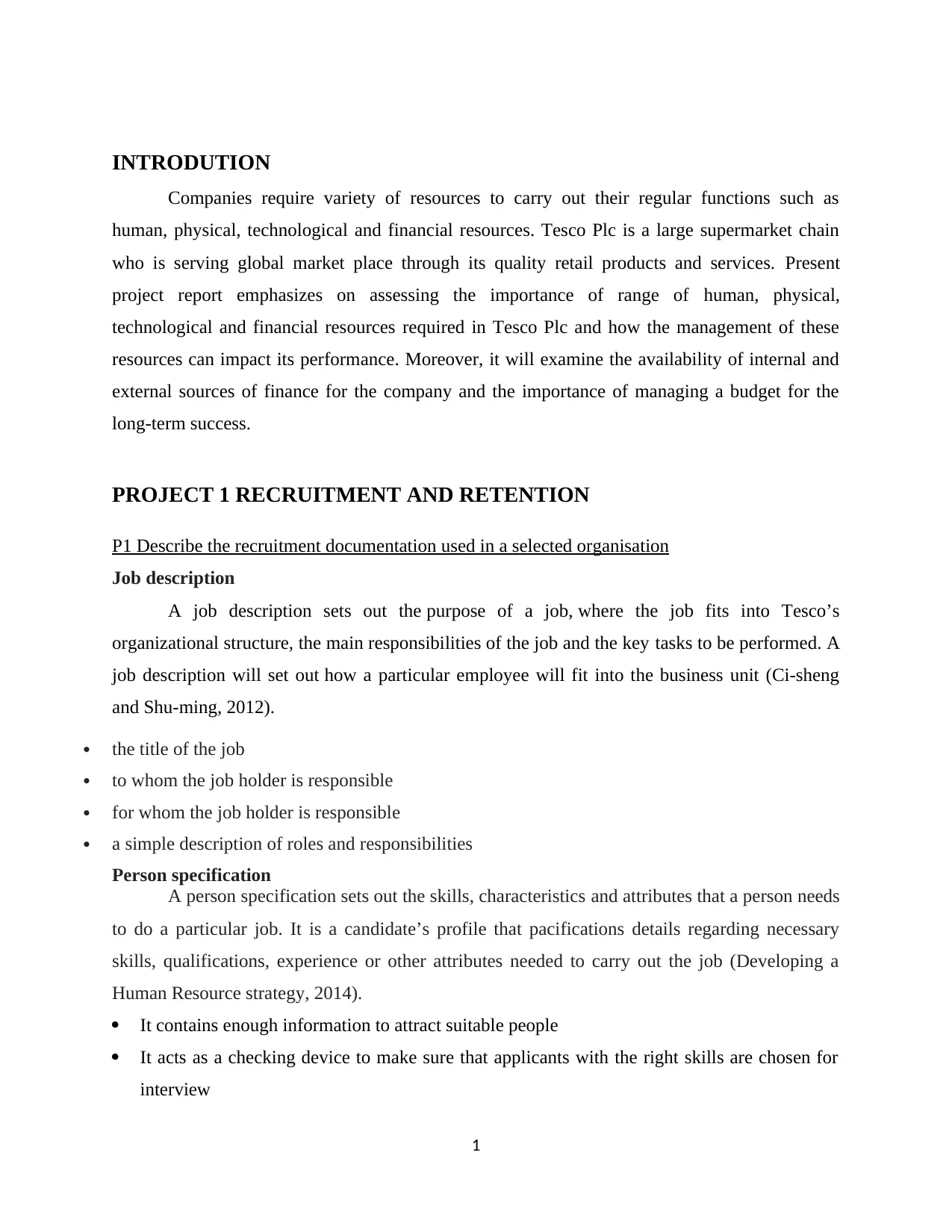
INTRODUTION
Companies require variety of resources to carry out their regular functions such as
human, physical, technological and financial resources. Tesco Plc is a large supermarket chain
who is serving global market place through its quality retail products and services. Present
project report emphasizes on assessing the importance of range of human, physical,
technological and financial resources required in Tesco Plc and how the management of these
resources can impact its performance. Moreover, it will examine the availability of internal and
external sources of finance for the company and the importance of managing a budget for the
long-term success.
PROJECT 1 RECRUITMENT AND RETENTION
P1 Describe the recruitment documentation used in a selected organisation
Job description
A job description sets out the purpose of a job, where the job fits into Tesco’s
organizational structure, the main responsibilities of the job and the key tasks to be performed. A
job description will set out how a particular employee will fit into the business unit (Ci-sheng
and Shu-ming, 2012).
the title of the job
to whom the job holder is responsible
for whom the job holder is responsible
a simple description of roles and responsibilities
Person specification
A person specification sets out the skills, characteristics and attributes that a person needs
to do a particular job. It is a candidate’s profile that pacifications details regarding necessary
skills, qualifications, experience or other attributes needed to carry out the job (Developing a
Human Resource strategy, 2014).
It contains enough information to attract suitable people
It acts as a checking device to make sure that applicants with the right skills are chosen for
interview
1
Companies require variety of resources to carry out their regular functions such as
human, physical, technological and financial resources. Tesco Plc is a large supermarket chain
who is serving global market place through its quality retail products and services. Present
project report emphasizes on assessing the importance of range of human, physical,
technological and financial resources required in Tesco Plc and how the management of these
resources can impact its performance. Moreover, it will examine the availability of internal and
external sources of finance for the company and the importance of managing a budget for the
long-term success.
PROJECT 1 RECRUITMENT AND RETENTION
P1 Describe the recruitment documentation used in a selected organisation
Job description
A job description sets out the purpose of a job, where the job fits into Tesco’s
organizational structure, the main responsibilities of the job and the key tasks to be performed. A
job description will set out how a particular employee will fit into the business unit (Ci-sheng
and Shu-ming, 2012).
the title of the job
to whom the job holder is responsible
for whom the job holder is responsible
a simple description of roles and responsibilities
Person specification
A person specification sets out the skills, characteristics and attributes that a person needs
to do a particular job. It is a candidate’s profile that pacifications details regarding necessary
skills, qualifications, experience or other attributes needed to carry out the job (Developing a
Human Resource strategy, 2014).
It contains enough information to attract suitable people
It acts as a checking device to make sure that applicants with the right skills are chosen for
interview
1
Paraphrase This Document
Need a fresh take? Get an instant paraphrase of this document with our AI Paraphraser
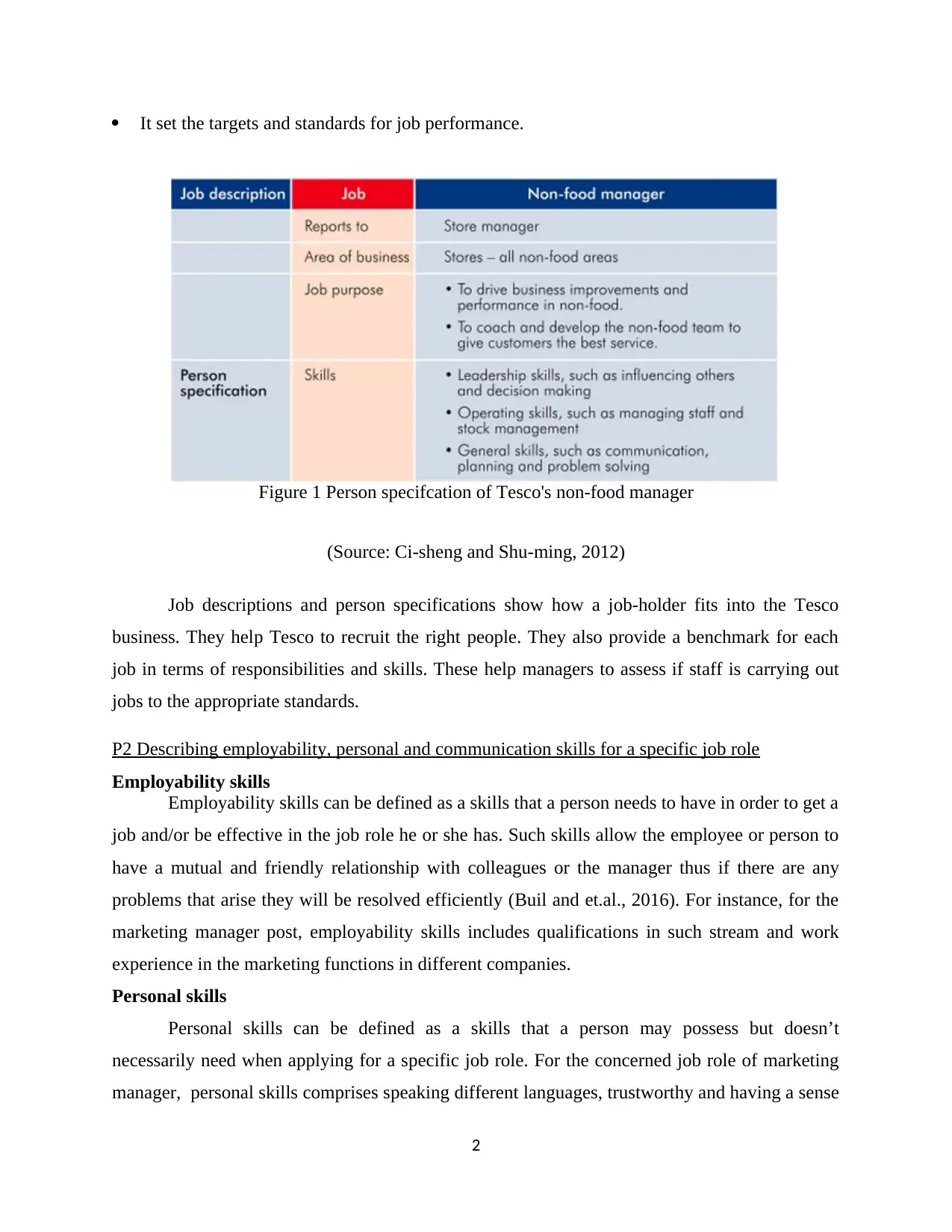
It set the targets and standards for job performance.
Figure 1 Person specifcation of Tesco's non-food manager
(Source: Ci-sheng and Shu-ming, 2012)
Job descriptions and person specifications show how a job-holder fits into the Tesco
business. They help Tesco to recruit the right people. They also provide a benchmark for each
job in terms of responsibilities and skills. These help managers to assess if staff is carrying out
jobs to the appropriate standards.
P2 Describing employability, personal and communication skills for a specific job role
Employability skills
Employability skills can be defined as a skills that a person needs to have in order to get a
job and/or be effective in the job role he or she has. Such skills allow the employee or person to
have a mutual and friendly relationship with colleagues or the manager thus if there are any
problems that arise they will be resolved efficiently (Buil and et.al., 2016). For instance, for the
marketing manager post, employability skills includes qualifications in such stream and work
experience in the marketing functions in different companies.
Personal skills
Personal skills can be defined as a skills that a person may possess but doesn’t
necessarily need when applying for a specific job role. For the concerned job role of marketing
manager, personal skills comprises speaking different languages, trustworthy and having a sense
2
Figure 1 Person specifcation of Tesco's non-food manager
(Source: Ci-sheng and Shu-ming, 2012)
Job descriptions and person specifications show how a job-holder fits into the Tesco
business. They help Tesco to recruit the right people. They also provide a benchmark for each
job in terms of responsibilities and skills. These help managers to assess if staff is carrying out
jobs to the appropriate standards.
P2 Describing employability, personal and communication skills for a specific job role
Employability skills
Employability skills can be defined as a skills that a person needs to have in order to get a
job and/or be effective in the job role he or she has. Such skills allow the employee or person to
have a mutual and friendly relationship with colleagues or the manager thus if there are any
problems that arise they will be resolved efficiently (Buil and et.al., 2016). For instance, for the
marketing manager post, employability skills includes qualifications in such stream and work
experience in the marketing functions in different companies.
Personal skills
Personal skills can be defined as a skills that a person may possess but doesn’t
necessarily need when applying for a specific job role. For the concerned job role of marketing
manager, personal skills comprises speaking different languages, trustworthy and having a sense
2
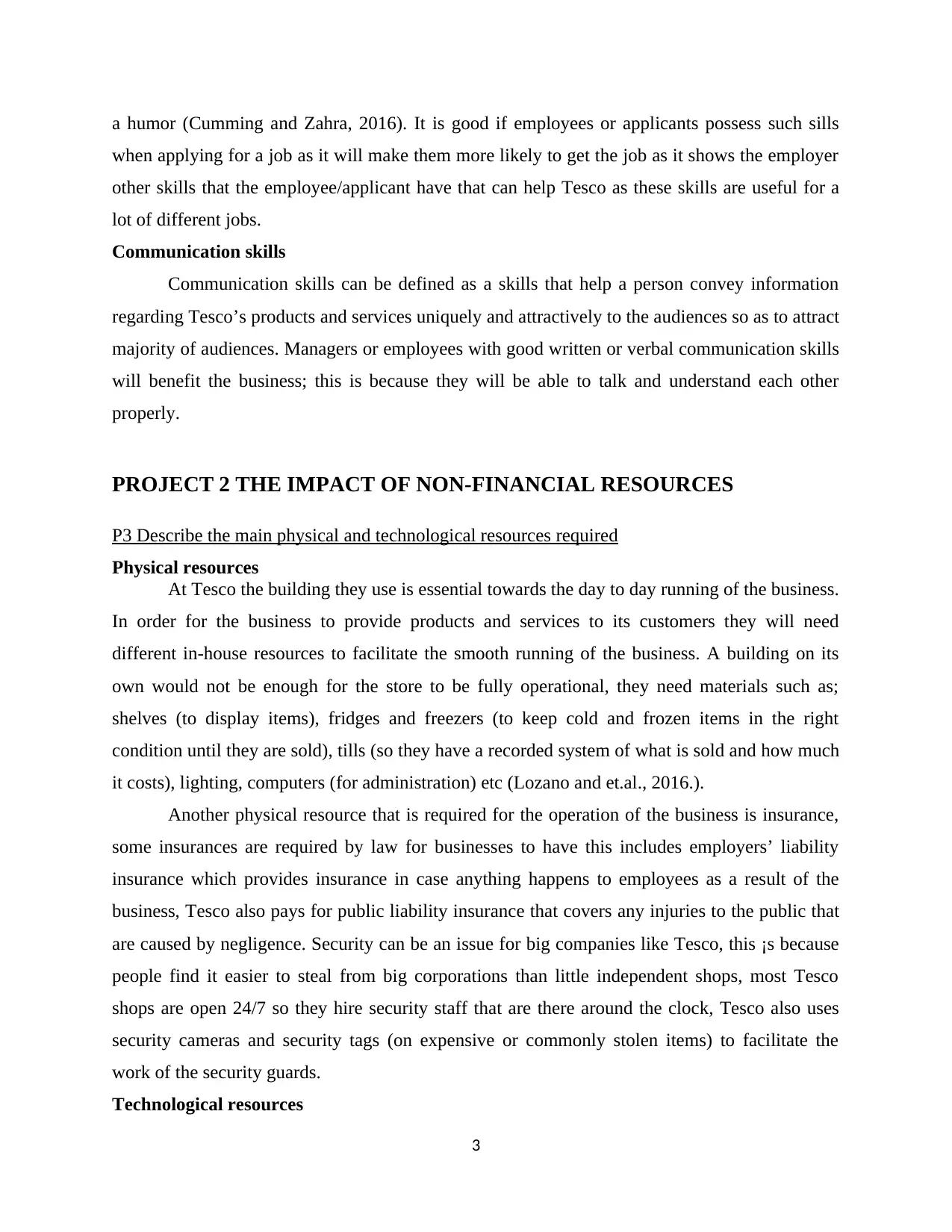
a humor (Cumming and Zahra, 2016). It is good if employees or applicants possess such sills
when applying for a job as it will make them more likely to get the job as it shows the employer
other skills that the employee/applicant have that can help Tesco as these skills are useful for a
lot of different jobs.
Communication skills
Communication skills can be defined as a skills that help a person convey information
regarding Tesco’s products and services uniquely and attractively to the audiences so as to attract
majority of audiences. Managers or employees with good written or verbal communication skills
will benefit the business; this is because they will be able to talk and understand each other
properly.
PROJECT 2 THE IMPACT OF NON-FINANCIAL RESOURCES
P3 Describe the main physical and technological resources required
Physical resources
At Tesco the building they use is essential towards the day to day running of the business.
In order for the business to provide products and services to its customers they will need
different in-house resources to facilitate the smooth running of the business. A building on its
own would not be enough for the store to be fully operational, they need materials such as;
shelves (to display items), fridges and freezers (to keep cold and frozen items in the right
condition until they are sold), tills (so they have a recorded system of what is sold and how much
it costs), lighting, computers (for administration) etc (Lozano and et.al., 2016.).
Another physical resource that is required for the operation of the business is insurance,
some insurances are required by law for businesses to have this includes employers’ liability
insurance which provides insurance in case anything happens to employees as a result of the
business, Tesco also pays for public liability insurance that covers any injuries to the public that
are caused by negligence. Security can be an issue for big companies like Tesco, this ¡s because
people find it easier to steal from big corporations than little independent shops, most Tesco
shops are open 24/7 so they hire security staff that are there around the clock, Tesco also uses
security cameras and security tags (on expensive or commonly stolen items) to facilitate the
work of the security guards.
Technological resources
3
when applying for a job as it will make them more likely to get the job as it shows the employer
other skills that the employee/applicant have that can help Tesco as these skills are useful for a
lot of different jobs.
Communication skills
Communication skills can be defined as a skills that help a person convey information
regarding Tesco’s products and services uniquely and attractively to the audiences so as to attract
majority of audiences. Managers or employees with good written or verbal communication skills
will benefit the business; this is because they will be able to talk and understand each other
properly.
PROJECT 2 THE IMPACT OF NON-FINANCIAL RESOURCES
P3 Describe the main physical and technological resources required
Physical resources
At Tesco the building they use is essential towards the day to day running of the business.
In order for the business to provide products and services to its customers they will need
different in-house resources to facilitate the smooth running of the business. A building on its
own would not be enough for the store to be fully operational, they need materials such as;
shelves (to display items), fridges and freezers (to keep cold and frozen items in the right
condition until they are sold), tills (so they have a recorded system of what is sold and how much
it costs), lighting, computers (for administration) etc (Lozano and et.al., 2016.).
Another physical resource that is required for the operation of the business is insurance,
some insurances are required by law for businesses to have this includes employers’ liability
insurance which provides insurance in case anything happens to employees as a result of the
business, Tesco also pays for public liability insurance that covers any injuries to the public that
are caused by negligence. Security can be an issue for big companies like Tesco, this ¡s because
people find it easier to steal from big corporations than little independent shops, most Tesco
shops are open 24/7 so they hire security staff that are there around the clock, Tesco also uses
security cameras and security tags (on expensive or commonly stolen items) to facilitate the
work of the security guards.
Technological resources
3
⊘ This is a preview!⊘
Do you want full access?
Subscribe today to unlock all pages.

Trusted by 1+ million students worldwide
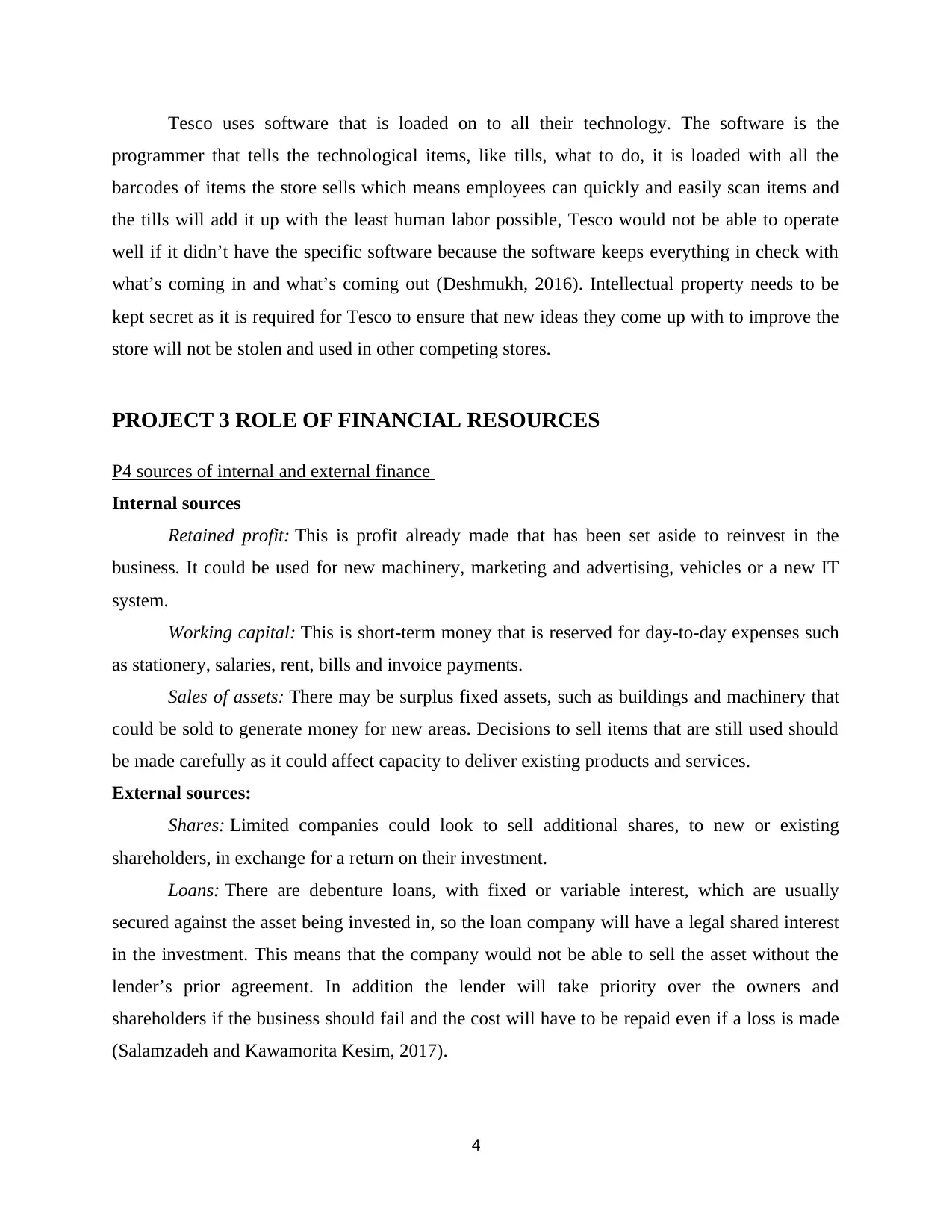
Tesco uses software that is loaded on to all their technology. The software is the
programmer that tells the technological items, like tills, what to do, it is loaded with all the
barcodes of items the store sells which means employees can quickly and easily scan items and
the tills will add it up with the least human labor possible, Tesco would not be able to operate
well if it didn’t have the specific software because the software keeps everything in check with
what’s coming in and what’s coming out (Deshmukh, 2016). Intellectual property needs to be
kept secret as it is required for Tesco to ensure that new ideas they come up with to improve the
store will not be stolen and used in other competing stores.
PROJECT 3 ROLE OF FINANCIAL RESOURCES
P4 sources of internal and external finance
Internal sources
Retained profit: This is profit already made that has been set aside to reinvest in the
business. It could be used for new machinery, marketing and advertising, vehicles or a new IT
system.
Working capital: This is short-term money that is reserved for day-to-day expenses such
as stationery, salaries, rent, bills and invoice payments.
Sales of assets: There may be surplus fixed assets, such as buildings and machinery that
could be sold to generate money for new areas. Decisions to sell items that are still used should
be made carefully as it could affect capacity to deliver existing products and services.
External sources:
Shares: Limited companies could look to sell additional shares, to new or existing
shareholders, in exchange for a return on their investment.
Loans: There are debenture loans, with fixed or variable interest, which are usually
secured against the asset being invested in, so the loan company will have a legal shared interest
in the investment. This means that the company would not be able to sell the asset without the
lender’s prior agreement. In addition the lender will take priority over the owners and
shareholders if the business should fail and the cost will have to be repaid even if a loss is made
(Salamzadeh and Kawamorita Kesim, 2017).
4
programmer that tells the technological items, like tills, what to do, it is loaded with all the
barcodes of items the store sells which means employees can quickly and easily scan items and
the tills will add it up with the least human labor possible, Tesco would not be able to operate
well if it didn’t have the specific software because the software keeps everything in check with
what’s coming in and what’s coming out (Deshmukh, 2016). Intellectual property needs to be
kept secret as it is required for Tesco to ensure that new ideas they come up with to improve the
store will not be stolen and used in other competing stores.
PROJECT 3 ROLE OF FINANCIAL RESOURCES
P4 sources of internal and external finance
Internal sources
Retained profit: This is profit already made that has been set aside to reinvest in the
business. It could be used for new machinery, marketing and advertising, vehicles or a new IT
system.
Working capital: This is short-term money that is reserved for day-to-day expenses such
as stationery, salaries, rent, bills and invoice payments.
Sales of assets: There may be surplus fixed assets, such as buildings and machinery that
could be sold to generate money for new areas. Decisions to sell items that are still used should
be made carefully as it could affect capacity to deliver existing products and services.
External sources:
Shares: Limited companies could look to sell additional shares, to new or existing
shareholders, in exchange for a return on their investment.
Loans: There are debenture loans, with fixed or variable interest, which are usually
secured against the asset being invested in, so the loan company will have a legal shared interest
in the investment. This means that the company would not be able to sell the asset without the
lender’s prior agreement. In addition the lender will take priority over the owners and
shareholders if the business should fail and the cost will have to be repaid even if a loss is made
(Salamzadeh and Kawamorita Kesim, 2017).
4
Paraphrase This Document
Need a fresh take? Get an instant paraphrase of this document with our AI Paraphraser
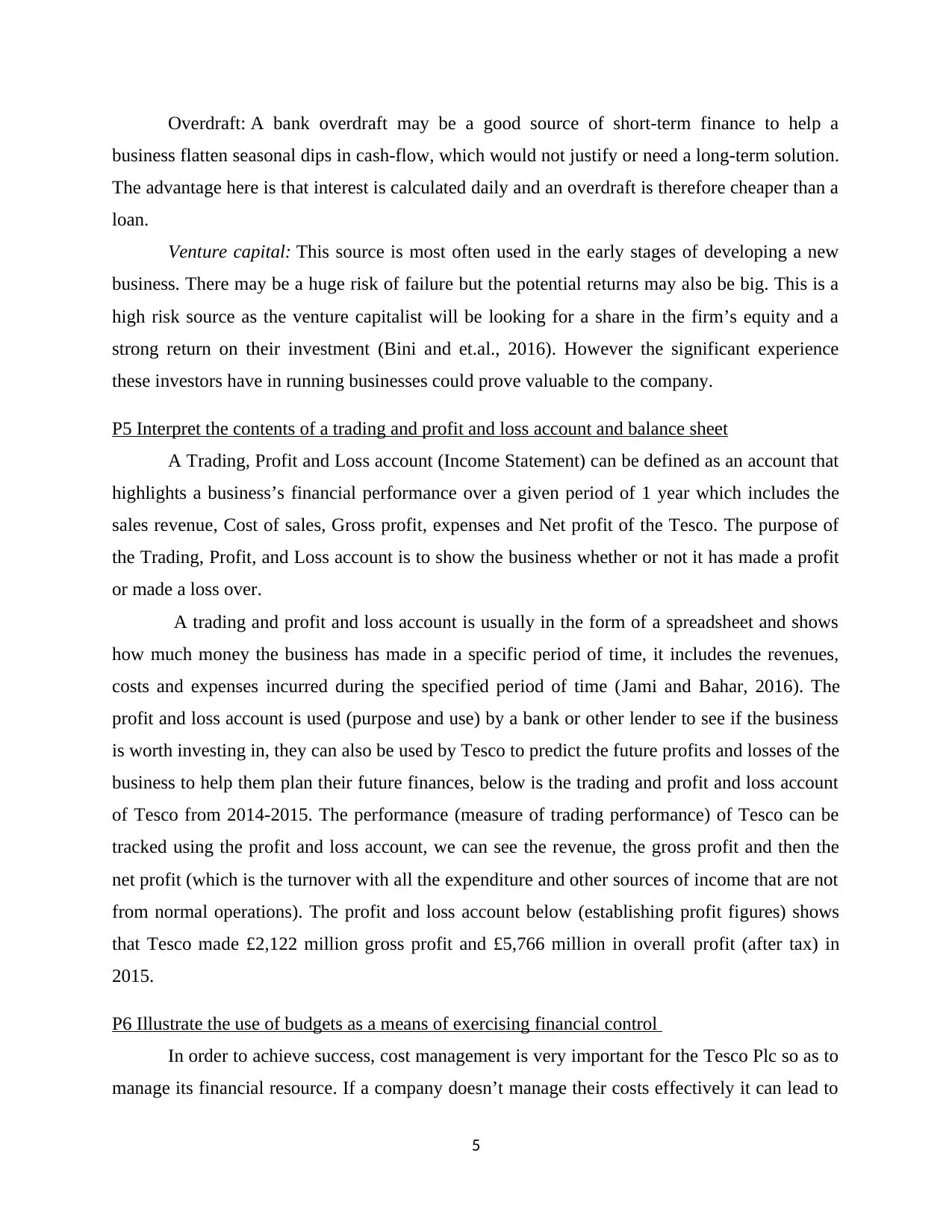
Overdraft: A bank overdraft may be a good source of short-term finance to help a
business flatten seasonal dips in cash-flow, which would not justify or need a long-term solution.
The advantage here is that interest is calculated daily and an overdraft is therefore cheaper than a
loan.
Venture capital: This source is most often used in the early stages of developing a new
business. There may be a huge risk of failure but the potential returns may also be big. This is a
high risk source as the venture capitalist will be looking for a share in the firm’s equity and a
strong return on their investment (Bini and et.al., 2016). However the significant experience
these investors have in running businesses could prove valuable to the company.
P5 Interpret the contents of a trading and profit and loss account and balance sheet
A Trading, Profit and Loss account (Income Statement) can be defined as an account that
highlights a business’s financial performance over a given period of 1 year which includes the
sales revenue, Cost of sales, Gross profit, expenses and Net profit of the Tesco. The purpose of
the Trading, Profit, and Loss account is to show the business whether or not it has made a profit
or made a loss over.
A trading and profit and loss account is usually in the form of a spreadsheet and shows
how much money the business has made in a specific period of time, it includes the revenues,
costs and expenses incurred during the specified period of time (Jami and Bahar, 2016). The
profit and loss account is used (purpose and use) by a bank or other lender to see if the business
is worth investing in, they can also be used by Tesco to predict the future profits and losses of the
business to help them plan their future finances, below is the trading and profit and loss account
of Tesco from 2014-2015. The performance (measure of trading performance) of Tesco can be
tracked using the profit and loss account, we can see the revenue, the gross profit and then the
net profit (which is the turnover with all the expenditure and other sources of income that are not
from normal operations). The profit and loss account below (establishing profit figures) shows
that Tesco made £2,122 million gross profit and £5,766 million in overall profit (after tax) in
2015.
P6 Illustrate the use of budgets as a means of exercising financial control
In order to achieve success, cost management is very important for the Tesco Plc so as to
manage its financial resource. If a company doesn’t manage their costs effectively it can lead to
5
business flatten seasonal dips in cash-flow, which would not justify or need a long-term solution.
The advantage here is that interest is calculated daily and an overdraft is therefore cheaper than a
loan.
Venture capital: This source is most often used in the early stages of developing a new
business. There may be a huge risk of failure but the potential returns may also be big. This is a
high risk source as the venture capitalist will be looking for a share in the firm’s equity and a
strong return on their investment (Bini and et.al., 2016). However the significant experience
these investors have in running businesses could prove valuable to the company.
P5 Interpret the contents of a trading and profit and loss account and balance sheet
A Trading, Profit and Loss account (Income Statement) can be defined as an account that
highlights a business’s financial performance over a given period of 1 year which includes the
sales revenue, Cost of sales, Gross profit, expenses and Net profit of the Tesco. The purpose of
the Trading, Profit, and Loss account is to show the business whether or not it has made a profit
or made a loss over.
A trading and profit and loss account is usually in the form of a spreadsheet and shows
how much money the business has made in a specific period of time, it includes the revenues,
costs and expenses incurred during the specified period of time (Jami and Bahar, 2016). The
profit and loss account is used (purpose and use) by a bank or other lender to see if the business
is worth investing in, they can also be used by Tesco to predict the future profits and losses of the
business to help them plan their future finances, below is the trading and profit and loss account
of Tesco from 2014-2015. The performance (measure of trading performance) of Tesco can be
tracked using the profit and loss account, we can see the revenue, the gross profit and then the
net profit (which is the turnover with all the expenditure and other sources of income that are not
from normal operations). The profit and loss account below (establishing profit figures) shows
that Tesco made £2,122 million gross profit and £5,766 million in overall profit (after tax) in
2015.
P6 Illustrate the use of budgets as a means of exercising financial control
In order to achieve success, cost management is very important for the Tesco Plc so as to
manage its financial resource. If a company doesn’t manage their costs effectively it can lead to
5
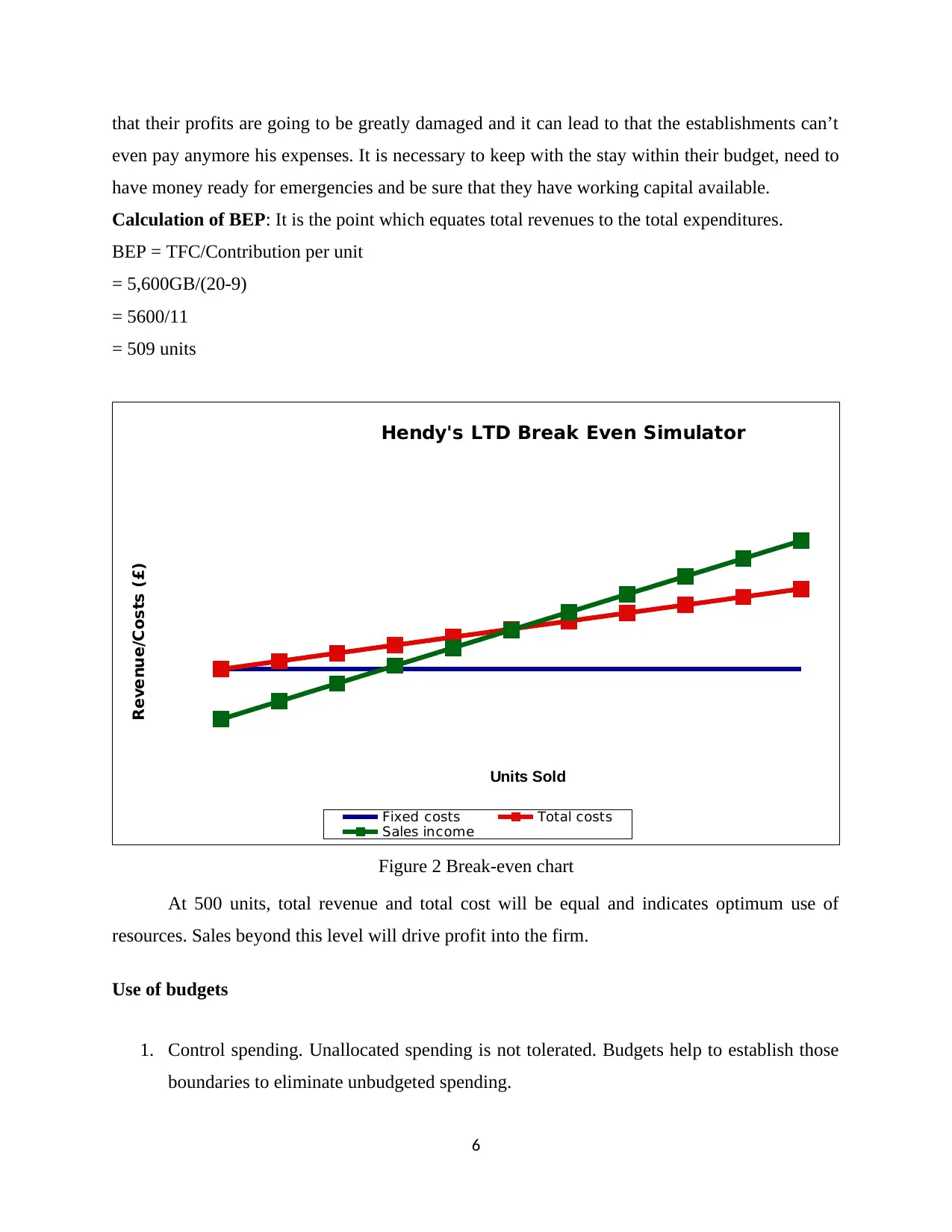
that their profits are going to be greatly damaged and it can lead to that the establishments can’t
even pay anymore his expenses. It is necessary to keep with the stay within their budget, need to
have money ready for emergencies and be sure that they have working capital available.
Calculation of BEP: It is the point which equates total revenues to the total expenditures.
BEP = TFC/Contribution per unit
= 5,600GB/(20-9)
= 5600/11
= 509 units
Hendy's LTD Break Even Simulator
Fixed costs Total costs
Sales income
Units Sold
Revenue/Costs (£)
Figure 2 Break-even chart
At 500 units, total revenue and total cost will be equal and indicates optimum use of
resources. Sales beyond this level will drive profit into the firm.
Use of budgets
1. Control spending. Unallocated spending is not tolerated. Budgets help to establish those
boundaries to eliminate unbudgeted spending.
6
even pay anymore his expenses. It is necessary to keep with the stay within their budget, need to
have money ready for emergencies and be sure that they have working capital available.
Calculation of BEP: It is the point which equates total revenues to the total expenditures.
BEP = TFC/Contribution per unit
= 5,600GB/(20-9)
= 5600/11
= 509 units
Hendy's LTD Break Even Simulator
Fixed costs Total costs
Sales income
Units Sold
Revenue/Costs (£)
Figure 2 Break-even chart
At 500 units, total revenue and total cost will be equal and indicates optimum use of
resources. Sales beyond this level will drive profit into the firm.
Use of budgets
1. Control spending. Unallocated spending is not tolerated. Budgets help to establish those
boundaries to eliminate unbudgeted spending.
6
⊘ This is a preview!⊘
Do you want full access?
Subscribe today to unlock all pages.

Trusted by 1+ million students worldwide
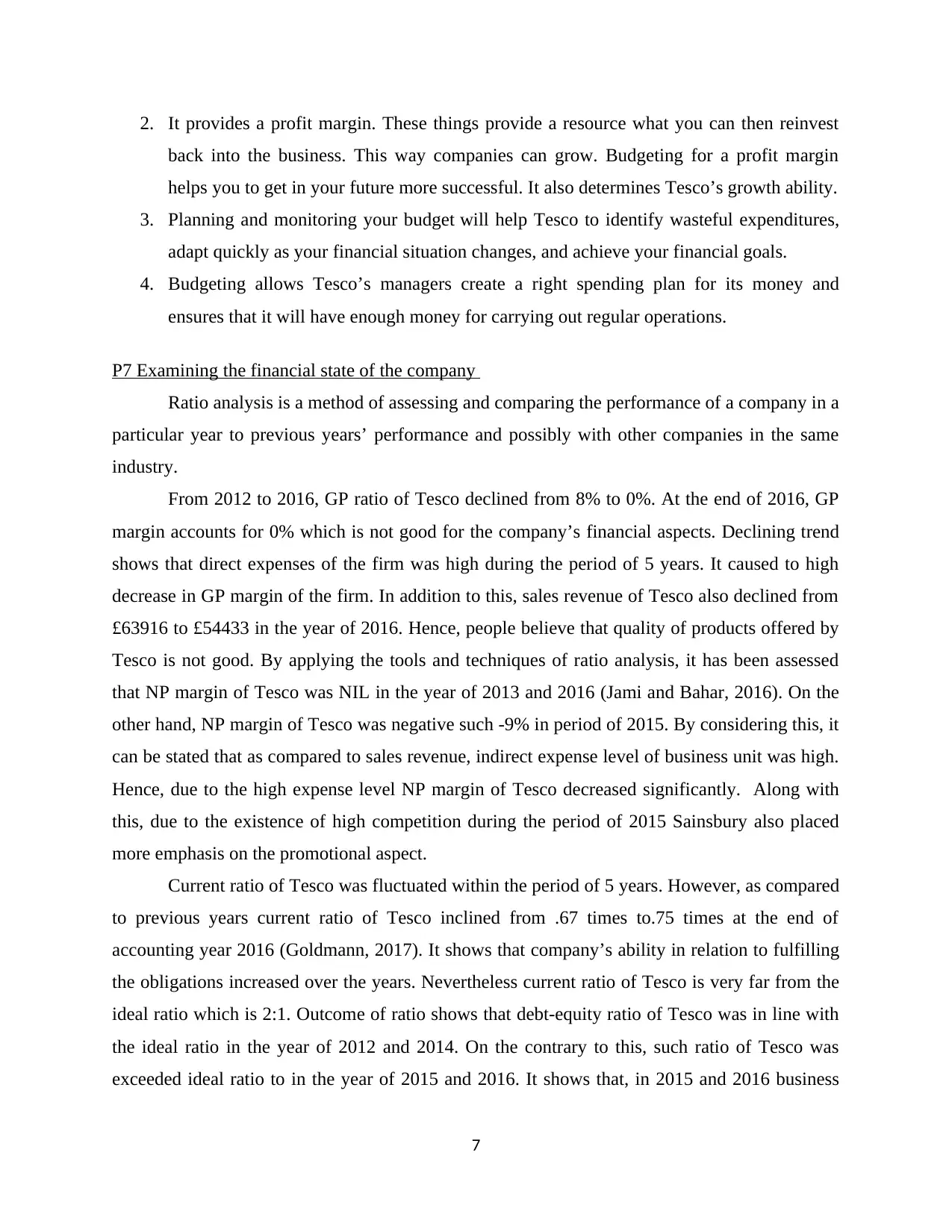
2. It provides a profit margin. These things provide a resource what you can then reinvest
back into the business. This way companies can grow. Budgeting for a profit margin
helps you to get in your future more successful. It also determines Tesco’s growth ability.
3. Planning and monitoring your budget will help Tesco to identify wasteful expenditures,
adapt quickly as your financial situation changes, and achieve your financial goals.
4. Budgeting allows Tesco’s managers create a right spending plan for its money and
ensures that it will have enough money for carrying out regular operations.
P7 Examining the financial state of the company
Ratio analysis is a method of assessing and comparing the performance of a company in a
particular year to previous years’ performance and possibly with other companies in the same
industry.
From 2012 to 2016, GP ratio of Tesco declined from 8% to 0%. At the end of 2016, GP
margin accounts for 0% which is not good for the company’s financial aspects. Declining trend
shows that direct expenses of the firm was high during the period of 5 years. It caused to high
decrease in GP margin of the firm. In addition to this, sales revenue of Tesco also declined from
£63916 to £54433 in the year of 2016. Hence, people believe that quality of products offered by
Tesco is not good. By applying the tools and techniques of ratio analysis, it has been assessed
that NP margin of Tesco was NIL in the year of 2013 and 2016 (Jami and Bahar, 2016). On the
other hand, NP margin of Tesco was negative such -9% in period of 2015. By considering this, it
can be stated that as compared to sales revenue, indirect expense level of business unit was high.
Hence, due to the high expense level NP margin of Tesco decreased significantly. Along with
this, due to the existence of high competition during the period of 2015 Sainsbury also placed
more emphasis on the promotional aspect.
Current ratio of Tesco was fluctuated within the period of 5 years. However, as compared
to previous years current ratio of Tesco inclined from .67 times to.75 times at the end of
accounting year 2016 (Goldmann, 2017). It shows that company’s ability in relation to fulfilling
the obligations increased over the years. Nevertheless current ratio of Tesco is very far from the
ideal ratio which is 2:1. Outcome of ratio shows that debt-equity ratio of Tesco was in line with
the ideal ratio in the year of 2012 and 2014. On the contrary to this, such ratio of Tesco was
exceeded ideal ratio to in the year of 2015 and 2016. It shows that, in 2015 and 2016 business
7
back into the business. This way companies can grow. Budgeting for a profit margin
helps you to get in your future more successful. It also determines Tesco’s growth ability.
3. Planning and monitoring your budget will help Tesco to identify wasteful expenditures,
adapt quickly as your financial situation changes, and achieve your financial goals.
4. Budgeting allows Tesco’s managers create a right spending plan for its money and
ensures that it will have enough money for carrying out regular operations.
P7 Examining the financial state of the company
Ratio analysis is a method of assessing and comparing the performance of a company in a
particular year to previous years’ performance and possibly with other companies in the same
industry.
From 2012 to 2016, GP ratio of Tesco declined from 8% to 0%. At the end of 2016, GP
margin accounts for 0% which is not good for the company’s financial aspects. Declining trend
shows that direct expenses of the firm was high during the period of 5 years. It caused to high
decrease in GP margin of the firm. In addition to this, sales revenue of Tesco also declined from
£63916 to £54433 in the year of 2016. Hence, people believe that quality of products offered by
Tesco is not good. By applying the tools and techniques of ratio analysis, it has been assessed
that NP margin of Tesco was NIL in the year of 2013 and 2016 (Jami and Bahar, 2016). On the
other hand, NP margin of Tesco was negative such -9% in period of 2015. By considering this, it
can be stated that as compared to sales revenue, indirect expense level of business unit was high.
Hence, due to the high expense level NP margin of Tesco decreased significantly. Along with
this, due to the existence of high competition during the period of 2015 Sainsbury also placed
more emphasis on the promotional aspect.
Current ratio of Tesco was fluctuated within the period of 5 years. However, as compared
to previous years current ratio of Tesco inclined from .67 times to.75 times at the end of
accounting year 2016 (Goldmann, 2017). It shows that company’s ability in relation to fulfilling
the obligations increased over the years. Nevertheless current ratio of Tesco is very far from the
ideal ratio which is 2:1. Outcome of ratio shows that debt-equity ratio of Tesco was in line with
the ideal ratio in the year of 2012 and 2014. On the contrary to this, such ratio of Tesco was
exceeded ideal ratio to in the year of 2015 and 2016. It shows that, in 2015 and 2016 business
7
Paraphrase This Document
Need a fresh take? Get an instant paraphrase of this document with our AI Paraphraser
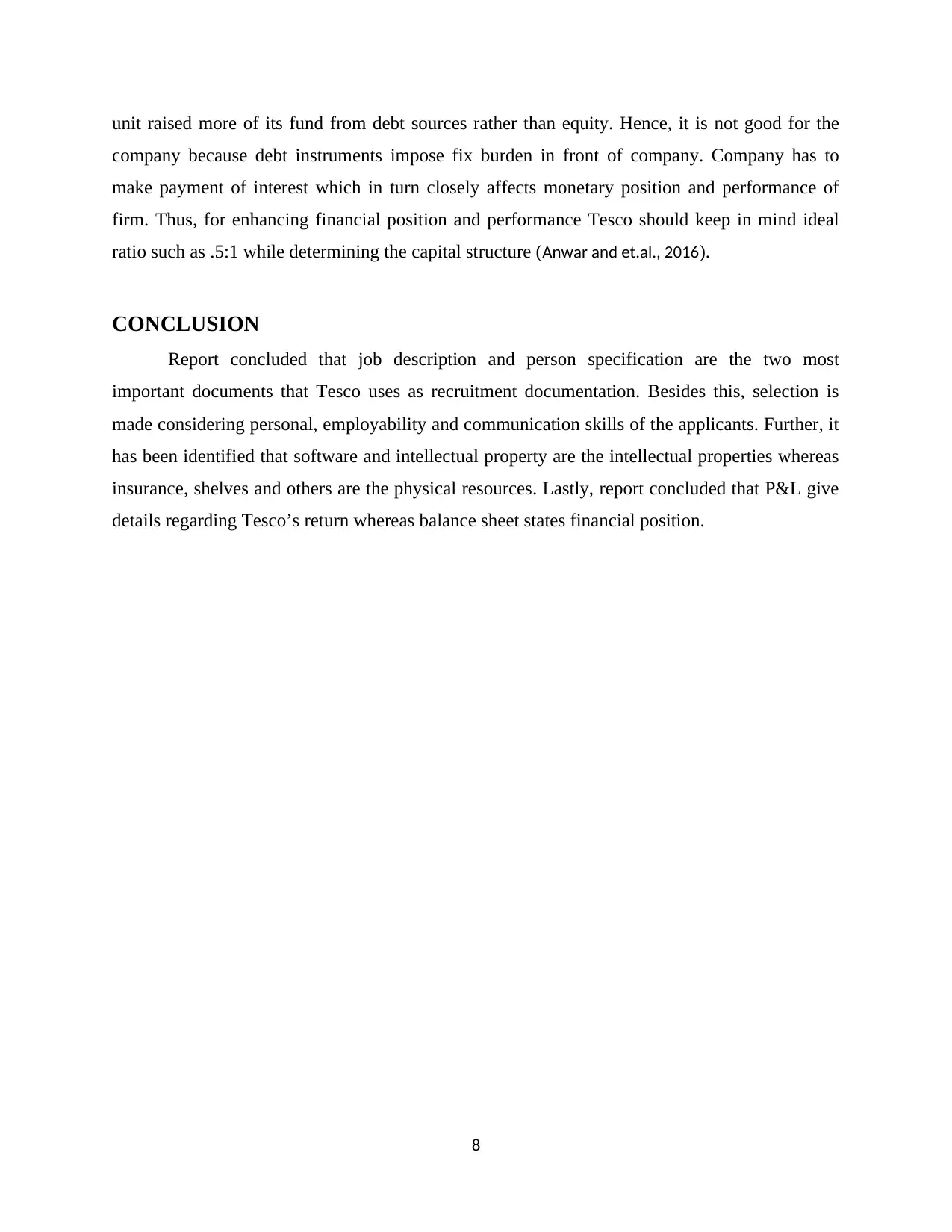
unit raised more of its fund from debt sources rather than equity. Hence, it is not good for the
company because debt instruments impose fix burden in front of company. Company has to
make payment of interest which in turn closely affects monetary position and performance of
firm. Thus, for enhancing financial position and performance Tesco should keep in mind ideal
ratio such as .5:1 while determining the capital structure (Anwar and et.al., 2016).
CONCLUSION
Report concluded that job description and person specification are the two most
important documents that Tesco uses as recruitment documentation. Besides this, selection is
made considering personal, employability and communication skills of the applicants. Further, it
has been identified that software and intellectual property are the intellectual properties whereas
insurance, shelves and others are the physical resources. Lastly, report concluded that P&L give
details regarding Tesco’s return whereas balance sheet states financial position.
8
company because debt instruments impose fix burden in front of company. Company has to
make payment of interest which in turn closely affects monetary position and performance of
firm. Thus, for enhancing financial position and performance Tesco should keep in mind ideal
ratio such as .5:1 while determining the capital structure (Anwar and et.al., 2016).
CONCLUSION
Report concluded that job description and person specification are the two most
important documents that Tesco uses as recruitment documentation. Besides this, selection is
made considering personal, employability and communication skills of the applicants. Further, it
has been identified that software and intellectual property are the intellectual properties whereas
insurance, shelves and others are the physical resources. Lastly, report concluded that P&L give
details regarding Tesco’s return whereas balance sheet states financial position.
8
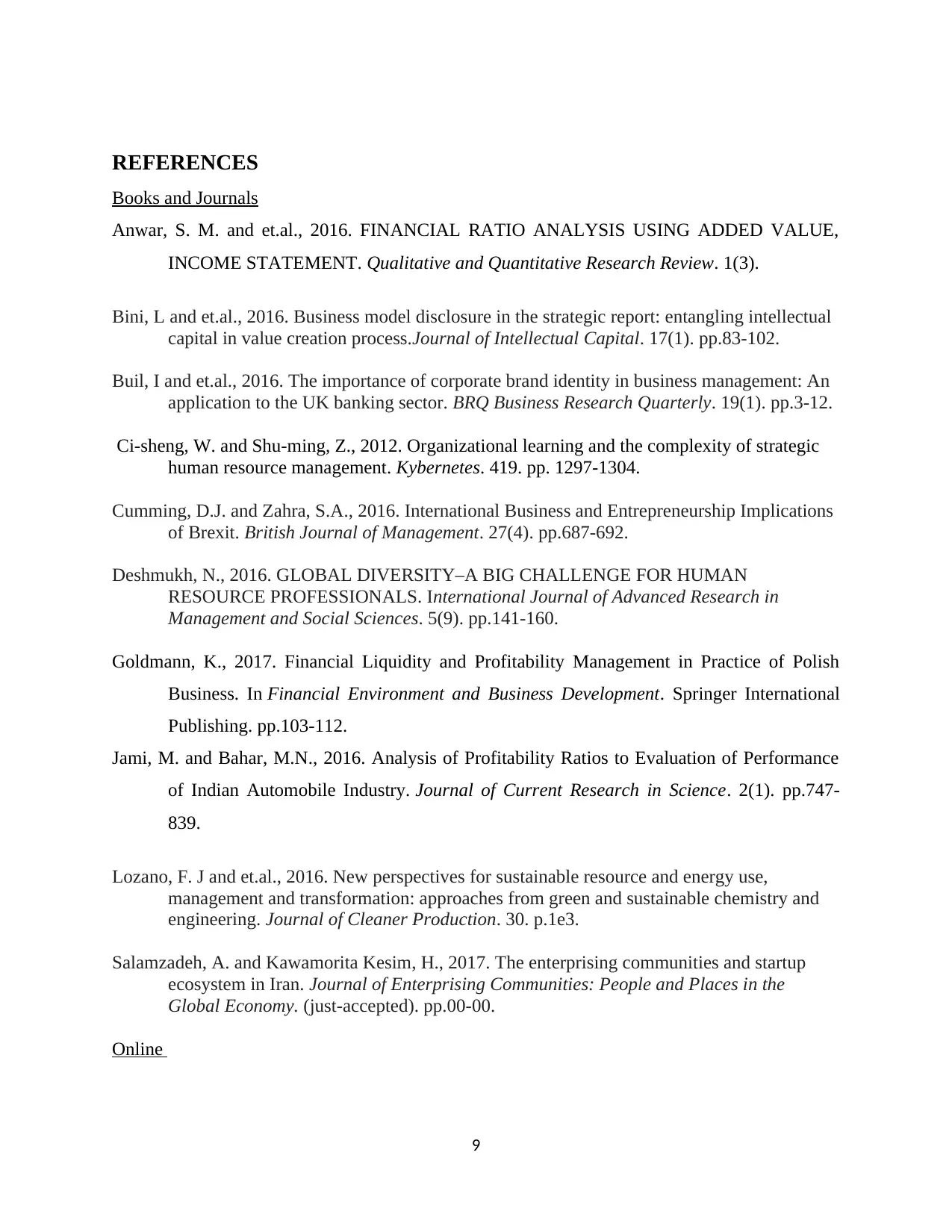
REFERENCES
Books and Journals
Anwar, S. M. and et.al., 2016. FINANCIAL RATIO ANALYSIS USING ADDED VALUE,
INCOME STATEMENT. Qualitative and Quantitative Research Review. 1(3).
Bini, L and et.al., 2016. Business model disclosure in the strategic report: entangling intellectual
capital in value creation process.Journal of Intellectual Capital. 17(1). pp.83-102.
Buil, I and et.al., 2016. The importance of corporate brand identity in business management: An
application to the UK banking sector. BRQ Business Research Quarterly. 19(1). pp.3-12.
Ci-sheng, W. and Shu-ming, Z., 2012. Organizational learning and the complexity of strategic
human resource management. Kybernetes. 419. pp. 1297-1304.
Cumming, D.J. and Zahra, S.A., 2016. International Business and Entrepreneurship Implications
of Brexit. British Journal of Management. 27(4). pp.687-692.
Deshmukh, N., 2016. GLOBAL DIVERSITY–A BIG CHALLENGE FOR HUMAN
RESOURCE PROFESSIONALS. International Journal of Advanced Research in
Management and Social Sciences. 5(9). pp.141-160.
Goldmann, K., 2017. Financial Liquidity and Profitability Management in Practice of Polish
Business. In Financial Environment and Business Development. Springer International
Publishing. pp.103-112.
Jami, M. and Bahar, M.N., 2016. Analysis of Profitability Ratios to Evaluation of Performance
of Indian Automobile Industry. Journal of Current Research in Science. 2(1). pp.747-
839.
Lozano, F. J and et.al., 2016. New perspectives for sustainable resource and energy use,
management and transformation: approaches from green and sustainable chemistry and
engineering. Journal of Cleaner Production. 30. p.1e3.
Salamzadeh, A. and Kawamorita Kesim, H., 2017. The enterprising communities and startup
ecosystem in Iran. Journal of Enterprising Communities: People and Places in the
Global Economy. (just-accepted). pp.00-00.
Online
9
Books and Journals
Anwar, S. M. and et.al., 2016. FINANCIAL RATIO ANALYSIS USING ADDED VALUE,
INCOME STATEMENT. Qualitative and Quantitative Research Review. 1(3).
Bini, L and et.al., 2016. Business model disclosure in the strategic report: entangling intellectual
capital in value creation process.Journal of Intellectual Capital. 17(1). pp.83-102.
Buil, I and et.al., 2016. The importance of corporate brand identity in business management: An
application to the UK banking sector. BRQ Business Research Quarterly. 19(1). pp.3-12.
Ci-sheng, W. and Shu-ming, Z., 2012. Organizational learning and the complexity of strategic
human resource management. Kybernetes. 419. pp. 1297-1304.
Cumming, D.J. and Zahra, S.A., 2016. International Business and Entrepreneurship Implications
of Brexit. British Journal of Management. 27(4). pp.687-692.
Deshmukh, N., 2016. GLOBAL DIVERSITY–A BIG CHALLENGE FOR HUMAN
RESOURCE PROFESSIONALS. International Journal of Advanced Research in
Management and Social Sciences. 5(9). pp.141-160.
Goldmann, K., 2017. Financial Liquidity and Profitability Management in Practice of Polish
Business. In Financial Environment and Business Development. Springer International
Publishing. pp.103-112.
Jami, M. and Bahar, M.N., 2016. Analysis of Profitability Ratios to Evaluation of Performance
of Indian Automobile Industry. Journal of Current Research in Science. 2(1). pp.747-
839.
Lozano, F. J and et.al., 2016. New perspectives for sustainable resource and energy use,
management and transformation: approaches from green and sustainable chemistry and
engineering. Journal of Cleaner Production. 30. p.1e3.
Salamzadeh, A. and Kawamorita Kesim, H., 2017. The enterprising communities and startup
ecosystem in Iran. Journal of Enterprising Communities: People and Places in the
Global Economy. (just-accepted). pp.00-00.
Online
9
⊘ This is a preview!⊘
Do you want full access?
Subscribe today to unlock all pages.

Trusted by 1+ million students worldwide
1 out of 13
Related Documents
Your All-in-One AI-Powered Toolkit for Academic Success.
+13062052269
info@desklib.com
Available 24*7 on WhatsApp / Email
![[object Object]](/_next/static/media/star-bottom.7253800d.svg)
Unlock your academic potential
Copyright © 2020–2025 A2Z Services. All Rights Reserved. Developed and managed by ZUCOL.





